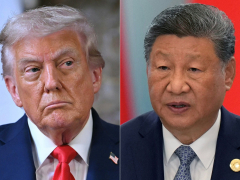United States President Donald Trump expects “a lot of problems” will be solved between Washington and Beijing when he meets China’s President Xi Jinping in South Korea for a high-stakes meeting on Thursday, amid growing trade tensions between the two.
Relations between the two world powers have been strained in recent years, with Washington and Beijing imposing tit-for-tat trade tariffs topping 100 percent against each other this year, the US restricting its exports of semiconductors vital for artificial intelligence (AI) development and Beijing restricting exports of critical rare-earth metals which are vital for the defence industry and also the development of AI, among other issues.
Recommended Stories
list of 3 items
- list 1 of 3Trump, Japan’s Takaichi sign deal to secure rare earths supply
- list 2 of 3China, ASEAN sign enhanced free trade pact amid Trump tariffs
- list 3 of 3‘Trump 2028’: Could the US president really go for a third term?
end of list
Officials from Washington and Beijing have been locked in trade talks since August to de-escalate trade tensions, and they also came up with a framework for a trade deal during meetings in Malaysia over the weekend.
On the sidelines of the Asia-Pacific Economic Cooperation (APEC) summit in Gyeongju, South Korea, on Wednesday, Trump said an expected trade deal between China and the US would be good for both countries and “something very exciting for everybody”.
But only a meeting between Trump and Xi can confirm if a trade deal is really in the making.
Expectations for the agreement are modest, with analysts expecting the two world powers to continue to clash over their myriad differences long-term.
When are the two leaders meeting?
Trump is scheduled to meet Xi on Thursday in the port city of Busan in southeastern South Korea. The meeting is expected to start at 11am local time (01: 00 GMT).
It will be the first time the leaders have met in person since Trump returned to the White House in January.
The US president last met Xi in 2019, during Trump’s first term, on the sidelines of the Group of 20 (G20) summit in Osaka, Japan.
“I think we’re going to have a great meeting with President Xi of China, and a lot of problems are going to be solved,” Trump told journalists on Wednesday on Air Force One while en route to South Korea.
On Wednesday, China’s Ministry of Foreign Affairs confirmed the meeting between Xi and Trump in a statement and said the leaders “will exchange views on bilateral relations and issues of mutual interest”.
What will Trump and Xi talk about?
Discussions are likely to cover:
- Trade tariffs
- Trafficking of fentanyl, a drug responsible for tens of thousands of deaths in the US each year
- China’s export controls on critical rare-earth metals and its purchase of US soya beans
- US export controls on semiconductors
- Geopolitical and security issues, particularly Russia’s war in Ukraine and Washington’s position on Taiwan
- Port fees on Chinese ships docking in US ports
- Finalising a deal to buy TikTok, the social media platform, from its Chinese owners
Alejandro Reyes, adjunct professor at the Department of Politics and Public Administration at the University of Hong Kong, told Al Jazeera that at this meeting, both sides will want to steady an uneasy rivalry – but for different reasons.
“For Washington, the goal is to show that its tough line on China has delivered results. The Trump team is walking into this summit after signing trade pacts with Malaysia, Cambodia and Japan that link market access directly to national security cooperation. These deals require America’s partners to align with US export controls and supply-chain rules – essentially making ‘economic security’ a shared obligation,” he said.
“For Beijing, the priority is to project calm and endurance. The meeting comes just after the fourth plenum, which reaffirmed Chinese leader Xi Jinping’s authority and set the direction for the next five-year plan. China’s message is that it has weathered Western pressure and is back to focusing on growth and domestic stability,” he added.
But discussions on disputes over trade tariffs, critical rare-earth metals, AI technology and geopolitical strategies, the issues that most define the current relationship between the US and China, according to Reyes, are not going to be easy to resolve.
“The mistrust is structural now – it’s built into how both countries think about power and security,” he said.
What are the sticking points?
Fentanyl
A key issue for the Trump administration is stopping the illegal flow of drugs, particularly fentanyl – a powerful synthetic opiate which is 50 times more potent than heroin – from China to the US. In February, Trump slapped a 20 percent trade tariff on all imports from China, citing Beijing’s lack of effort in curbing the flow of the drug into the US.
In a media briefing note sent to Al Jazeera by the German Marshall Fund of the United States, Bonnie Glaser, managing director of GMF’s Indo-Pacific programme, said the fentanyl trade has been “a really contentious issue between the US and China”.
“From what I have heard, a criminal money-laundering cooperation supports the fentanyl trade, and this is where China is willing to cooperate, in a way where it will have minimum negative impact on their domestic situation,” she said at a briefing held in Washington, DC, on Tuesday.
Late on Tuesday, The Wall Street Journal reported that during Thursday’s meeting, “China is expected to commit to more controls on the export of so-called precursor chemicals used to make fentanyl.” The newspaper added that if this agreement is reached, Trump would reduce the tariffs imposed because of fentanyl by as much as 10 percent.
Trade tariffs
Following the fentanyl-related tariffs, in March, China imposed a 15 percent tariff on a range of US farm exports in retaliation, triggering a tit-for-tat tariff war.
In April, Trump raised tariffs on Chinese imports to 145 percent, prompting China to hit back with 125 percent tariffs of its own.
Washington and Beijing later cut tariffs to 30 percent and 10 percent, respectively, in May, and agreed to a 90-day truce in August for trade talks. The truce has been extended twice, but despite repeated talks, a trade agreement has not been reached.
Rare-earth metals and soya beans
China has restricted exports of 12 critical rare-earth metals this year, as well as of the machinery needed to refine these metals, citing security reasons. Beijing also said its restrictions were in response to US restrictions on the Chinese maritime, logistics and shipbuilding industries.
The first seven metals to be restricted were announced in April, while the remaining five were announced on October 10. These metals are crucial for the defence industry and for developing AI technology.
In October, Trump responded by threatening to impose 100 percent tariffs on China from November 1, citing Beijing’s strict export controls on critical rare earths as the reason for the tariffs.
Trump added that the US would also impose export controls on “any and all critical software”.
Reyes noted that while the US wants guaranteed access to rare earths and battery materials, it signed a new agreement with Japan and trade clauses with Malaysia this week, which aim to reduce the US dependence on China for these. “Beijing sees this as an effor





